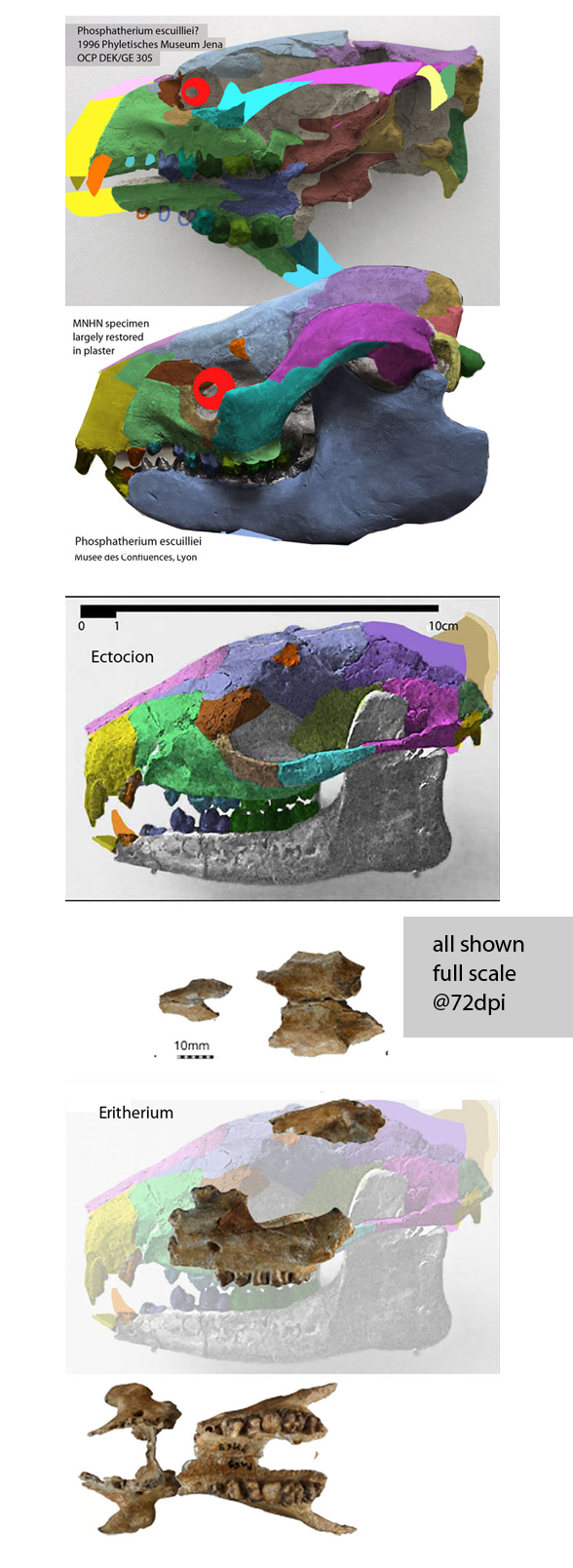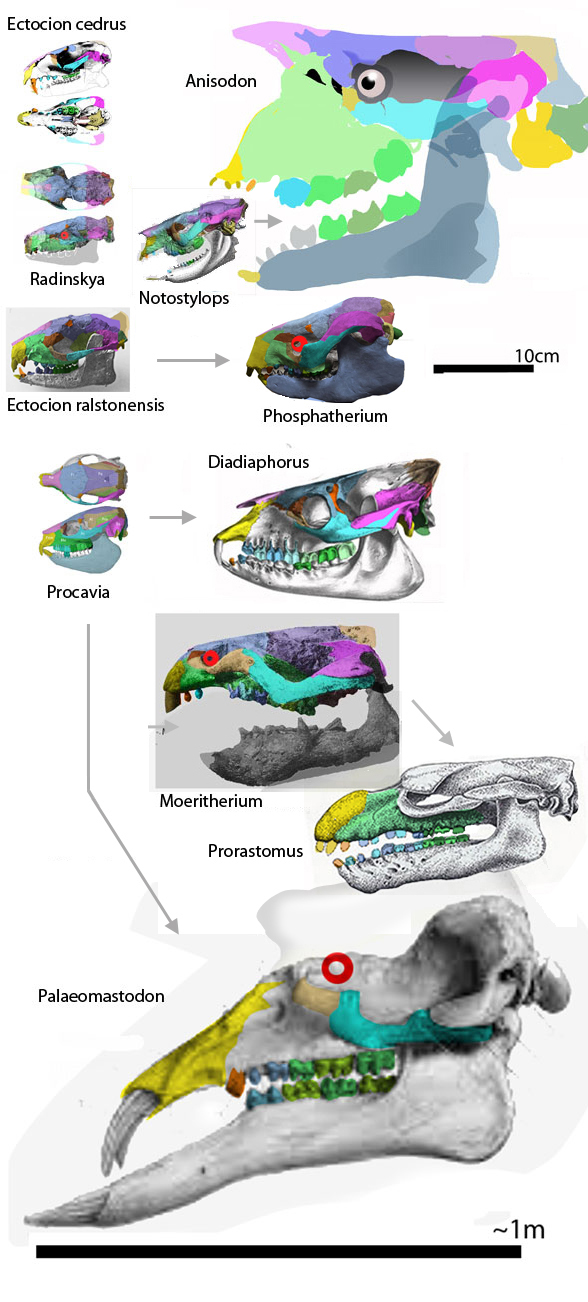Phosphatherium escuillei (Gheerbrant, Sudre and Cappetta 1996; Late Paleocene; 10cm skull length; Fig 1) has been a traditional elephant ancestor since its discovery (Gheerbrant, Sudre and Cappetta 1996) and rediscovery as a second specimen (Gheerbrant E et al. 2005; Gheerbrant 2009) assigned to the same genus and species.
After testing
in the large reptile tree (LRT, 2062 taxa, subset Fig 3) both new Phosphatherium specimens nest together, but derived from the more plesiomorphic, Ectocion ralstonensis (Fig 1), a taxon omitted by prior authors. That means Phosphaterium is less of an elephant ancestor than is the omitted, more plesiomorphic Late Paleocene taxon, Ectocion ralstonensis (Cope 1882 a, e; Granger 1915; Thewissen 1990). “A Palaeocene proboscidean from Morocco” got published in Nature in 2005. I’m guessing, “An Ectocion descendant leaving no descendants” would not have gotten published in Nature. Ya gotta do, whatcha gotta do in paleo.
In the LRT taxa closer to elephants include
Procavia, the hyrax, basal to sirenians. These two taxa and their descendants have a single pair of incisor tusks at most.

Here two Phosphatherium skulls
(Fig 1) are not the same species, but share more traits with each other than with other taxa.

Phosphatherium was close to the ancestry of elephants
(Fig 2) but several taxa were closer, despite the big bone appearance of Phosphatherium, convergent with elephants.

Gheerbrant 2009 described the partial remains of Eritherium azzouzorum,
(Fig 1) as “the oldest and most primitive elephant relative” at 60mya, 5 million years earlier than Phosphatherium. The partial remains consist of a palate (maxilla + jugals) and teeth, plus paired frontals and nasals. This is too little to fragmentary for the LRT, but note how well the pieces fit into a coeval Ectocion ralstonensis bauplan (Fig 1). Here the subhead, “Also a hyrax and manatee relative” would have been appropriate. The LRT lists elephant ancestors back to the Cambrian, just like every other included taxon.
Gheerbrant 2005 wrote:
“We report here significant new material belonging to the oldest and most primitive known Proboscidean, Phosphatherium escuilliei Gheerbrant, Sudre & Cappetta, 1996, from the early Eocene of the Ouled Abdoun phosphatic basin, Morocco. This material permits the first reconstruction of the skull and most of upper and lower dentition of Phosphatherium escuilliei.”
This second specimen (Fig. 1) does bring much needed data to this genus.
“The species, which is one of the oldest and most primitive known representatives of modern orders of ungulates, becomes one of the best known among them. Its dentition shows a noticeable dental variability, which is interpreted, at least provisionally, to be intraspecific.
Elephants don’t have diverse post-incisor tooth morphology like more primitive taxa do.
“The skull of Phosphatherium escuilliei is very primitive in many respects. It is long with an elongated facial part and a narrow rostrum. The toothrow does not extend posteriorly beyond the middle of the skull. The nasals are long and located anteriorly (i.e. nasal fossa not retracted). There is no contact between the premaxilla and frontal. There is a strong postorbital constriction and a distinct postorbital process on the frontal. The zygomatic arches are noticeably expanded laterally.
That lateral expansion is not shared with Ectocion, sirenians or elephants.
“The sagittal and nuchal crests are strong. The external auditory meatus is open ventrally. The braincase is strongly compressed laterally”.
In other words, the brain was not wide or large.
“Some primitive features of the dentition are also noticeable.“
That means distinct incisors, canines, premolars and molars.
“However, Phosphatherium escuilliei displays several strikingly advanced features, especially proboscidean and tethytherian features. A cladistic study of 129 features of Phosphatherium escuilliei supports the monophyly of Proboscidea and the inclusion of Phosphatherium within the order.
The LRT does not confirm the inclusion of Phosphatherium within the clade of elephants.
“The most significant Proboscidean synapomorphies found in Phosphatherium are: 1) the well developed zygomatic process of the maxillary which contributes significantly to the ventral border of the orbit and to the zygomatic arch; 2) the relatively large size of the pars mastoidea of the periotic; and 3) the hypoconulid in a labial position (a state unique to Proboscidea).“
The Gheerbrant et al. 2005 taxon list
included Ectocion (but which species?) representing the suprageneric taxon ‘Phenacodontidae’. The authors mistakenly included the unrelated suprageneric clades, Embrithopoda, Anthracobunidae and Desmostylia, erroneously following current textbooks and traditions. The authors employ Perissodactylia, a related clade, but again it is used as a suprageneric taxon. That’s always dangerous and rife with bias and cherry-picking. The authors employ a long list of dental traits not used by the LRT.
By contrast
the LRT employs no suprageneric taxa and no chimaera taxa, only specimens and species. That’s why both Phosphatherium taxa (Fig. 1) entered the LRT separately. In the LRT there is no cherry-picking of data from suprageneric taxa to suit an author preference.
The omission of Ectocion ralstonensis from prior analyses needs to be repaired in future studies on elephant origins.
The Phosphatherium authors employed taxa not tested in the LRT.
One: Late Paleocene Phenacolophus is a mandible + teeth taxon.
Two: Late Paleocene Minchenella (= Conolophus, preoccupied by an iguana) was described by Domning, Ray and McKenna 1986 as “a suitable candidate to be the common ancestor of both the Desmostylia and the Proboscidea” based on a molar cusp. The LRT separates these two clades based on more complete skeletons. More on that issue tomorrow.
References
Domning DP, Ray CE and McKenna MC 1986. Two New Oligocene Desmostylians and a Discussion of Tethytherian Systematics. Smithsonian Contributions to Paleobiology 59:56pp.
Gheerbrant E, Sudre J and Cappetta H 1996. A Palaeocene proboscidean from Morocco. Nature. 383 (6595): 68–71.
Gheerbrant E et al. 2005. Nouvelles données sur Phosphatherium escuilliei (Mammalia, Proboscidea) de l’Éocène inférieur du Maroc, apports à la phylogénie des Proboscidea et des ongulés lophodontes. Geodiversitas 27 (2), 2005, pp. 239-333.
Gheerbrant E 2009. Paleocene emergence of elephant relatives and the rapid radiation of African ungulates. Proc Natl Acad Sci USA. 106(26): 10717–10721.
